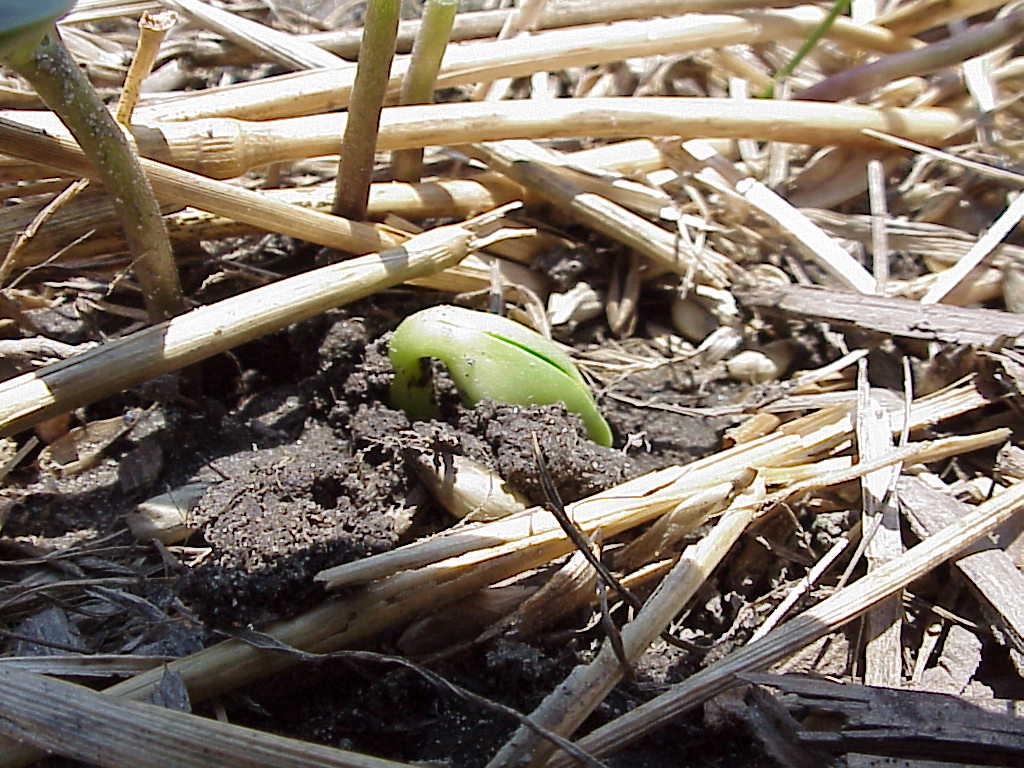Once the seed is in the ground with good soil-to-seed contact (insuring a good environment for germination), we must then turn our attention to getting the growing plant out of the ground as quickly as possible and insuring that it survives. The longer the seed takes to germinate and emerge, the greater likelihood of poor stands and unhealthy plants.
Soil Moisture and Seedbed Condition. Always try to plant into moist soils. However, I recognize that this is easier said than done, especially when several hundred acres of soybean needs to be planted and it’s getting closer and closer to wheat harvest or you need to side-dress the corn, or many other things need doing. Still, seed are expensive and replanting is even more expensive.
If the soil is completely dry, then the seed will usually wait on moisture. Unfortunately, during dry times, the field is rarely completely dry.  If there is enough moisture to swell the seed but not get the seedling out of the ground, then we have a problem. Seed need to imbibe over half of their weight in water to germinate. The critical seed moisture content for germination is 20%. Germination is not affected if the seed has imbibed water for 6 hours (seed is swollen, but seed coat not broken), then it dehydrates to 10% moisture. If seed has imbibed water for 12-24 hours (seed coat is broken, no radical), then germination may be reduced 35-40%. If the radical has emerged and seed drops to 10% moisture, few if any seedlings will survive.
If there is enough moisture to swell the seed but not get the seedling out of the ground, then we have a problem. Seed need to imbibe over half of their weight in water to germinate. The critical seed moisture content for germination is 20%. Germination is not affected if the seed has imbibed water for 6 hours (seed is swollen, but seed coat not broken), then it dehydrates to 10% moisture. If seed has imbibed water for 12-24 hours (seed coat is broken, no radical), then germination may be reduced 35-40%. If the radical has emerged and seed drops to 10% moisture, few if any seedlings will survive.
Surface soil compaction will physically hinder emergence and also result in less soil moisture because of less pore space. Row spacing will affect seedling emergence under crusted or compacted soil conditions because seed are closer together within the row; therefore, will exert more upward force, per foot of row, to emerge.
Soil Temperature. The ideal temperature for soybean germination is 77OF and the optimum range is 68 to 86OF. The maximum is 94OF, where temperature will actually inhibit germination. Planting early (mid-April to mid-May) may delay emergence due to cool soils. Planting in July increases risk of high soil temperatures, but soil moisture during this time of year is usually the bigger problem. I did see high temperature inhibition in some of our double-crop plantings in 2010. Regardless, if the soil temperature is not in the optimum range, emergence will be delayed. With this delay comes a greater likelihood of the seedling being attacked by disease or insects.
Planting Depth. Soybean seed depth should be between ¾ to 1¼ inches. If topsoil moisture is lacking, use the deeper placement, but never plant deeper than 1½ inches. If topsoil is adequate shallower seed placement may speed up emergence, but probably won’t make much difference under warm soil conditions. Just make sure that the seed is in contact with moist soil. Placement depth is controlled by the gauge wheels. Ideally, these should be adjacent to the disk opener. If controlled by the seed firming/closing wheel, then uniformity of seed depth could be erratic. The deeper you plant, the longer it takes for the seedling to emerge. The seedling physically has further to go to emerge, plus the soil may be cooler at deeper depths. Germination and emergence rate is controlled by temperature. So, when soils are warm, deeper planting depth has less detrimental effect on emergence. If soils are hot, deeper placement may actually be beneficial. Finally, uniform time of emergence of seedlings should be a goal even though soybean compensate well.
Protecting the Seed and Seedling. Certain environments such as cold soils, non-rotated land, poor quality seed, or a field history of insect pests or disease favor specific pests. Again, the greater time required for emergence, the greater probability that the seed will become infected with soil-borne disease. Therefore, rapid emergence is the best defense against seedling disease. No-tillage/high residues, early planting, planting into cold soils, and deep seed placement are all factors that may delay emergence; therefore, your management will need to be adjusted when one or more of these conditions are present. Seed treatments will protect the seed and seedling if emergence is delayed, but should only be used if other methods to decrease emergence time have been exhausted.
To review, here’s a checklist for rapid seedling emergence:
- Know the germination and vigor of your seed.
- Insure good soil-to-seed contact
- Plant soybeans ¾ to 1 ½ inches deep and into sufficient soil moisture.
- Plant into warm soils (68 to 86OF).
- Consider fungicide seed treatments if planting early into cool soils.
